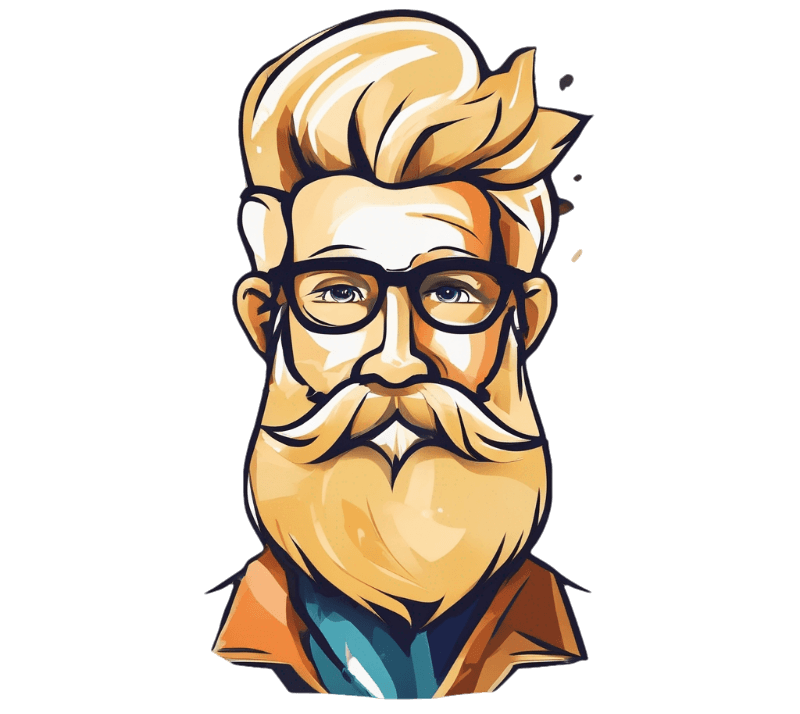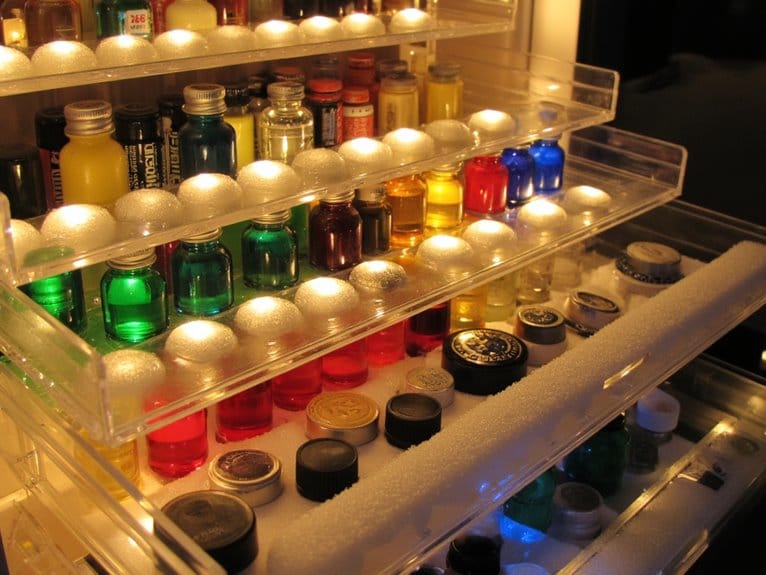We are supported by our audience. When you purchase through links on our site, we may earn an affiliate commission, at no extra cost for you. Learn more. Last update on 1st July 2025 / Images from Amazon Product Advertising API.
I’ve noticed that lacking a solid understanding of color theory, relying too heavily on pre-mixed colors, shying away from challenges, sticking to comfort zones, and neglecting continuous learning, might be holding you back in your figure painting hobby. These factors could be limiting your growth and creativity in this art form. If you explore how to tackle these obstacles, you can potentially discover new levels of skill and artistry in your figure painting journey.
Lack of Color Theory Understanding
Lacking a solid grasp of color theory hampers one’s ability to create engaging and well-balanced color schemes for miniature figure painting. Understanding color theory is vital for enhancing the painting content and overall visual impact of your miniatures. It involves delving into color relationships, contrasts, and how different colors interact to evoke specific emotions or moods within your painting.
Without a foundation in color theory, choosing the right colors for shading, highlighting, or creating realistic effects can become a challenging task. It is like trying to write a compelling story without understanding the basics of plot development or character arcs. Mastery of color theory empowers painters to mix colors effectively and achieve desired results with confidence and precision.
When painting miniatures, each color choice should contribute to the overall narrative or theme of the figure. Without a grasp of color theory, these choices may lack intentionality, resulting in a disjointed or unappealing final product. Just as a writer carefully selects words to convey meaning, a painter must select colors purposefully to convey the desired mood or message within their painting content.
In essence, a solid understanding of color theory is the backbone of successful miniature figure painting. It provides the tools necessary to create dynamic, visually pleasing compositions that captivate viewers and elevate the quality of your work.
Dependence on Pre-Mixed Colors
Relying heavily on pre-mixed colors can impede my growth as a figure painter, limiting my ability to experiment with various shades and tones. This reliance may stifle my creativity and prevent me from fully understanding the intricacies of color mixing. Breaking away from this dependency is essential for me to develop my color confidence and expand my painting techniques.
Color Mixing Basics
Embracing the fundamentals of color mixing in figure painting liberates artists from the constraints of pre-mixed colors, fostering a deeper understanding of the intricate nuances within the palette. By mastering color mixing techniques using primary colors like red, yellow, and blue, creative color combinations become limitless. Exploring the color wheel opens doors to a spectrum of possibilities, enabling precise control over shades, tones, and highlights in miniatures. Experimenting with mixing colors from scratch not only enhances skill but also allows for personalized color palettes and unique painting styles. Overcoming the reliance on pre-mixed colors paves the way for customization and precision in miniature painting, enriching the overall artistic experience and elevating the quality of the final creations.
Developing Color Confidence
Developing color confidence in figure painting involves exploring the art of mixing primary colors to reveal a broader spectrum of creative possibilities and enhance overall painting techniques. By mastering color blending techniques and engaging in creative experimentation, artists can break free from the limitations of pre-mixed colors. This exploration allows for personalized palettes and the discovery of unique color harmonies. Moreover, understanding color depth through mixing primaries leads to more vibrant compositions. Artists who embrace this process tend to have a deeper grasp of color theory, resulting in dynamic and richly textured artworks. Overcoming the dependence on pre-mixed colors opens up a world of artistic expression and empowers individuals to create truly original pieces.
Fear of Embracing Challenges
Confronting challenges head-on is crucial in figure painting as it paves the way for growth and skill enhancement. Embracing challenges with a growth mindset is essential for artistic development. Fear avoidance often leads to skill stagnation, hindering the progression of painting miniatures. By facing obstacles, painters can experience an artistic breakthrough, discovering new techniques and styles that can elevate their work to new heights.
Avoiding challenges out of fear can limit creativity and impede the learning process. Overcoming these challenges not only improves technical skills but also fosters a deeper understanding of the craft. Embracing new challenges, whether it be painting a different subject matter or experimenting with unconventional techniques, can result in more satisfying and rewarding painting experiences.
Stepping out of one’s comfort zone and confronting difficult tasks head-on can lead to significant growth in figure painting. By pushing boundaries and trying new approaches, painters can break through creative barriers that may have previously held them back. These breakthroughs not only enhance technical proficiency but also build confidence and resilience in the hobby of figure painting.
Staying Within Comfort Zones
Remaining complacent within familiar boundaries stifles the evolution and creativity potential of figure painting enthusiasts. It is essential to step out of comfort zones to discover new possibilities and enhance artistic skills. Here are some critical points to contemplate regarding the impact of staying within comfort zones:
- Exploration Opportunities: By venturing beyond what is comfortable, painters can unearth new techniques, styles, and approaches that can elevate their work to new heights.
- Growth Potential: Embracing challenges and trying new methods fosters personal and artistic growth, enabling painters to expand their repertoire and improve their abilities.
- Artistic Boundaries: Boundaries are meant to be pushed and tested. By staying within comfort zones, artists limit their potential for innovation and creativity.
Stepping out of comfort zones can be challenging, but it is a necessary step towards progress in figure painting. It is through exploring the unknown, embracing challenges, and breaking away from familiar routines that painters can truly evolve and reach new levels of artistic expression. So, don’t let fear of the unknown hold you back; instead, see it as an opportunity for growth and self-discovery in your figure painting journey.
Neglecting Continuous Learning
I’ve noticed that neglecting continuous learning in figure painting can lead to a lack of practice, resulting in stagnant skill development. Ignoring new techniques and approaches can hinder artistic growth and limit creativity. It’s essential to push past comfort zones and actively seek opportunities for improvement to evolve as a figure painter.
Lack of Practice
In the domain of figure painting, neglecting continuous learning by not engaging in regular practice can lead to a detrimental lack of progress and growth in one’s artistic abilities. Consistent practice is important for skill improvement and developing a growth mindset in painting. Here are five key reasons why practice consistency is essential:
- Regular practice is essential for improving painting skills and techniques.
- Neglecting continuous learning can result in stagnation and lack of progress in figure painting.
- Consistent practice helps in mastering new painting styles and approaches.
- Engaging in regular painting sessions allows for experimentation and growth as a painter.
- Developing a painting routine fosters creativity and confidence in tackling challenging projects.
Ignoring New Techniques
Neglecting to explore new techniques in figure painting significantly hinders artistic growth and proficiency in the hobby. Technique exploration is vital for skill enhancement and overall artistic growth. By staying within familiar methods, one limits the potential for development and improvement. Embracing new approaches not only expands one’s skill set but also opens up opportunities for creativity. Continuous learning in figure painting is a journey that allows artists to adapt to various challenges and broaden their horizons. Ignoring new techniques can lead to stagnation and a plateau in skill development. To progress and evolve as a figure painter, it is essential to remain curious, open-minded, and willing to experiment with different styles and methods.
Stagnant Skill Development
Continuous learning plays a pivotal role in the advancement of skills within the domain of figure painting, ensuring growth and proficiency over time. Neglecting continuous learning can lead to stagnant skill development, hindering overall progress. To overcome this obstacle, it is essential to focus on the following key aspects:
- Embracing new brush techniques to add depth and detail to paintings.
- Experimenting with various lighting effects to create mood and dimension in artworks.
- Incorporating a variety of textures to enhance the richness and realism of figures.
- Regularly practicing different styles and methods to expand artistic capabilities.
- Seeking feedback and learning from mistakes to refine techniques and evolve as a figure painter.
Lack of Confidence and Clear Goals
A lack of confidence and clear goals in figure painting can hinder progress and limit creative exploration in this hobby. Building self-esteem and setting targets are essential components to advancing your skills and enjoying the process. Here are some key points to ponder:
- Setting clear painting goals: Having specific objectives provides direction and motivation in your hobby journey. It helps you focus your efforts and stay committed to improving your skills.
- Building self-esteem: Confidence in your abilities allows you to tackle challenges and experiment with new techniques. Believing in your potential as a painter can boost creativity and drive you to push your boundaries.
- Tracking progress: Having a vision for your painting style helps you monitor your development and celebrate achievements. It allows you to see how far you’ve come and where you still want to go.
- Staying focused: Clear goals help you stay on track and committed to enhancing your painting skills. They prevent distractions and keep you moving forward in your artistic endeavors.
- Boosting creativity: Confidence and clear goals not only improve technical skills but also foster creativity. They give you the freedom to explore new ideas and approaches in your figure painting.


